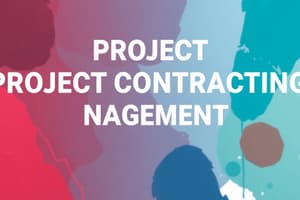Podcast
Questions and Answers
What is the typical number of firms selected for selective tendering?
What is the typical number of firms selected for selective tendering?
- 15 to 20 tenderers
- 3 to 4 tenderers
- 10 to 12 tenderers
- 5 to 8 tenderers (correct)
In two stage selective tendering, the contractor selection is completed before agreeing on the contract sum.
In two stage selective tendering, the contractor selection is completed before agreeing on the contract sum.
False (B)
What is the main purpose of negotiated tendering?
What is the main purpose of negotiated tendering?
To negotiate prices with one contractor based on competitive pricing.
In serial tendering, the first phase is conducted in __________, while subsequent phases are negotiated.
In serial tendering, the first phase is conducted in __________, while subsequent phases are negotiated.
Match the following tendering methods with their key characteristics:
Match the following tendering methods with their key characteristics:
What is the primary aim of procurement in construction?
What is the primary aim of procurement in construction?
A tender is a submission made by a client to potential suppliers.
A tender is a submission made by a client to potential suppliers.
What is the purpose of a pre-qualification questionnaire (PQQ)?
What is the purpose of a pre-qualification questionnaire (PQQ)?
Procurement is the acquisition of goods and/or services at the best possible total cost of ownership in the right ______ and quality, at the right time, in the right place.
Procurement is the acquisition of goods and/or services at the best possible total cost of ownership in the right ______ and quality, at the right time, in the right place.
Match the tendering methods with their characteristics:
Match the tendering methods with their characteristics:
Which of the following best describes the tendering process?
Which of the following best describes the tendering process?
Selective tendering allows any supplier to submit a tender.
Selective tendering allows any supplier to submit a tender.
What is the outcome of the tendering process?
What is the outcome of the tendering process?
Flashcards
Selective Tendering
Selective Tendering
A procurement method where a select group of 5 to 8 contractors are invited to submit bids. The selection process for these firms is crucial.
Single Stage Selective Tendering
Single Stage Selective Tendering
A procurement method where the contractor selection and contract price are determined simultaneously. Tender documents are submitted to a pre-selected group of contractors, evaluated, and the best bid wins.
Two Stage Selective Tendering
Two Stage Selective Tendering
A two-step procurement process where the contractor is chosen first, based on their pricing structure and other criteria, and then the contract price is negotiated separately.
Negotiated Tendering
Negotiated Tendering
Signup and view all the flashcards
Serial Tendering
Serial Tendering
Signup and view all the flashcards
Procurement in Construction
Procurement in Construction
Signup and view all the flashcards
Tender
Tender
Signup and view all the flashcards
Pre-qualification Questionnaire (PQQ)
Pre-qualification Questionnaire (PQQ)
Signup and view all the flashcards
Open Tendering
Open Tendering
Signup and view all the flashcards
Two-stage Tendering
Two-stage Tendering
Signup and view all the flashcards
Negotiated/Nomination Tendering
Negotiated/Nomination Tendering
Signup and view all the flashcards
Study Notes
Course Information
- Course Title: PROJECT MANAGEMENT
- Course Code: 0404438
- Course Leader: Prof. Alex Opoku (PhD, MSc, BSc (Hons), PGCHE, FHEA, MCIOB, FRICS), Professor of Sustainable Built Environment
Learning Outcomes
- Understand what a project is, project management, and the role/responsibilities of the project manager within a construction team.
- Understand how project managers manage projects integrating scope, time, cost, quality, human resources, communications, risk, and procurement.
- Applying methods for estimating time and cost, and managing quality in construction.
- Learning theories of leadership, communication, motivation, and conflict management within teams.
- Understanding procurement and risk management and their relationship.
Project Management Knowledge Areas
- Project Integration Management
- Project Scope Management
- Project Time Management
- Project Cost Management
- Project Quality Management
- Project Human Resources Management
- Project Communications Management
- Project Risk Management
- Project Procurement Management
- Project Stakeholder Management
Project Procurement Management
- Procurement is not just purchasing; it's the framework for bringing about, acquiring, or obtaining construction.
- Acquisition of goods/services at the best possible total cost of ownership, in the right quantity and quality, at the right time and place.
- Essential processes: Plan, Conduct, Control, Close.
Procurement Management Processes (Detailed)
- Plan Procurement: Develop Project Management Plan, Requirement Collection, Risk Identification, Resource Estimation, Project Schedule, Cost Calculation, Stakeholder Identification.
- Conduct Procurement: Make or buy decision, Procurement management Plan, Statement of work for procurement, Policy for source selection.
- Control Procurement: Work Performance Information, Change Request, Quality Reports, Project Document Update, Organizational process asset update.
- Close Procurement: Closed Contract, Update to Organizational process asset.
Procurement Management Process (Detailed) - Inputs, Tools/Techniques, and Outputs
- Plan: Inputs: Project charter, Statement of Work, Tools/Techniques: Meetings, Expert Judgement; Outputs: Project plan, Work breakdown structure, Budget.
- Conduct: Inputs: Work performance information, Budget, Tools/Techniques: Meetings, Audits, Project Management Information System (PMIS); Outputs: Project document updates, Budget updates.
- Control/Administer: Inputs: Assets, Work performance information, Budget, Tools/Techniques: Meetings, Audits, Project Management Information System (PMIS); Outputs: Work performance report, Project plan updates, Budget updates.
- Close: Inputs: Project charter, Statement of Work, Budget documents, Tools/Techniques: Meetings, Audits, Project Management Information System (PMIS); Outputs: Closing summary.
Tendering Procedures
- Tender: Submission by a prospective supplier to an invitation to tender (ITT).
- Pre-qualification Questionnaire (PQQ) and pre-tender interview: To create a shortlist of suitable suppliers for a project, reducing inefficiency and wasted effort in the tender process.
- Tendering process stages: Produce tender documents, Invite firms to tender, Receive tenders, Evaluate tenders, Appoint contractor.
Tendering Methods
- Open Tendering: No restrictions, free trade, advert in trade press, invites firms to bid.
- Selective Tendering: Small number of firms selected, usually 5-8 tenderers, selection is key. Includes single and two-stage options.
- Negotiated/Nomination Tendering: One contractor, prices are negotiated, based on competitive price for similar work.
- Serial Tendering: Phases in competition, subsequent phases are given, remaining phases are negotiated.
Specific Tendering Methods Details
- Single Stage Selective Tendering: Contractor selection and contract sum are done simultaneously.
- Two Stage Selective Tendering: Contractor selection is separate from contract sum agreement. Firms bid on their pricing structure and other criteria; evaluation predicts best value for money.
- Two Stage Selective Tendering (Process): Stage One: Select the Contractor (Tender list, Tender documents, Tenderers advise); Stage Two: Determine the Contract Sum (Design finalised, Documents produced, Priced, Negotiation).
- Negotiated Tendering: Used when preference/business relationship, continuation of contract, specialist expertise or equipment, quick start are important.
- Serial Tendering: Useful for repetitive work.
Studying That Suits You
Use AI to generate personalized quizzes and flashcards to suit your learning preferences.




